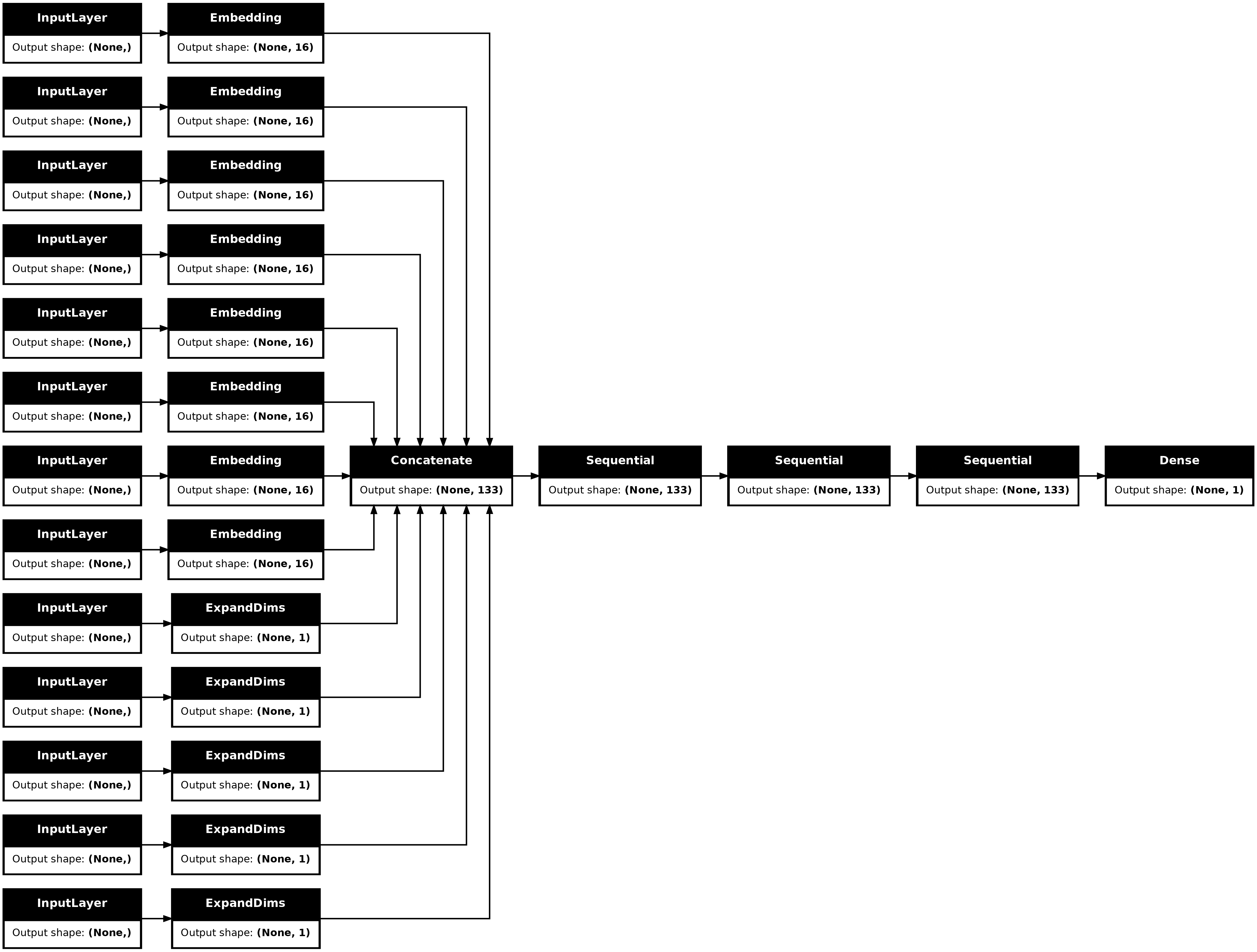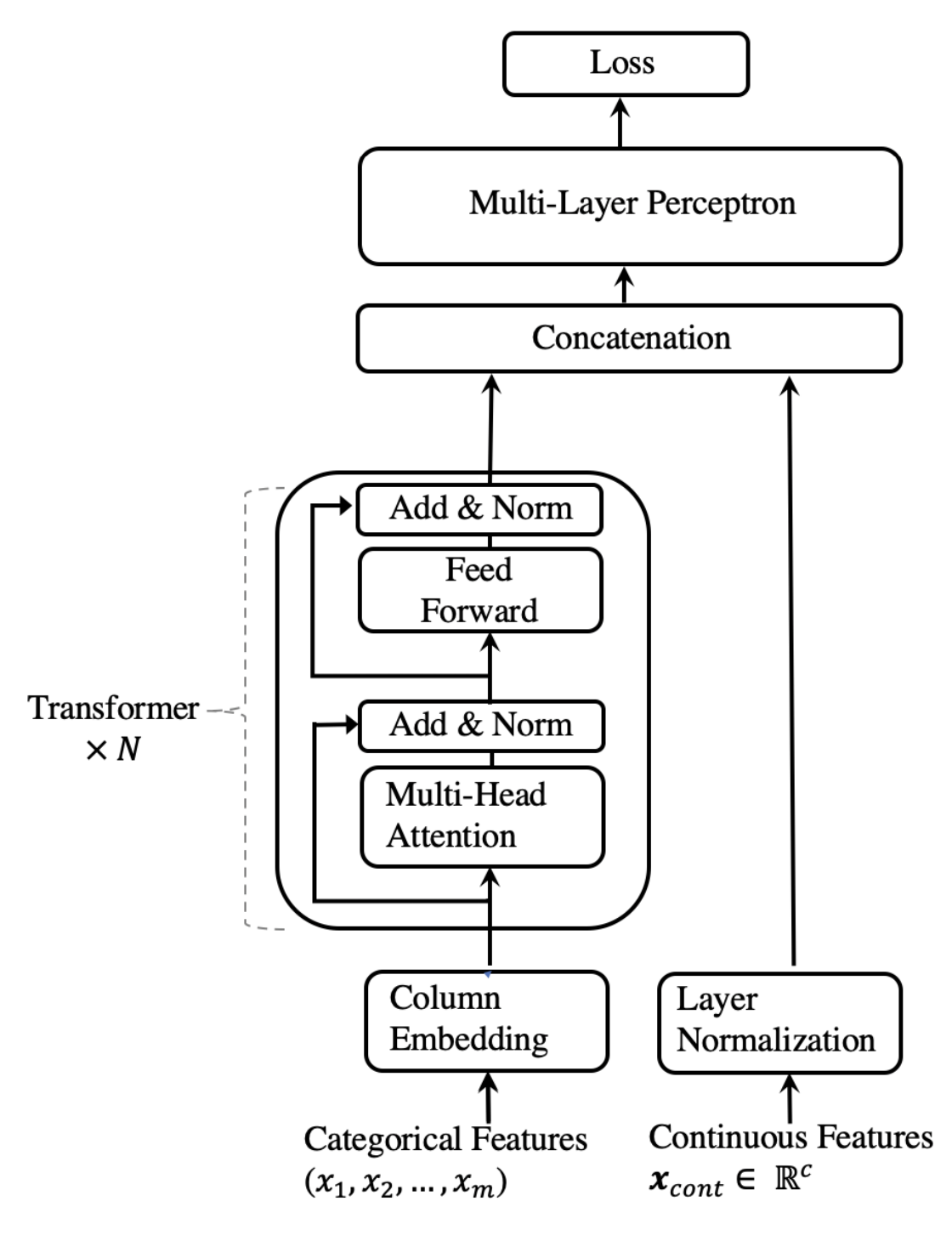使用 TabTransformer 進行結構化資料學習
作者: Khalid Salama
建立日期 2022/01/18
最後修改日期 2022/01/18
描述: 使用上下文嵌入進行結構化資料分類。
簡介
這個範例展示如何使用 TabTransformer 進行結構化資料分類,TabTransformer 是一種用於監督式和半監督式學習的深度表格資料建模架構。TabTransformer 基於自注意力 Transformer 建構。Transformer 層將類別特徵的嵌入轉換為強大的上下文嵌入,以實現更高的預測準確度。
設定
import keras
from keras import layers
from keras import ops
import math
import numpy as np
import pandas as pd
from tensorflow import data as tf_data
import matplotlib.pyplot as plt
from functools import partial
準備資料
這個範例使用 美國人口普查收入資料集,該資料集由 UC Irvine 機器學習儲存庫提供。這項任務是二元分類,以預測一個人是否可能年收入超過 50,000 美元。
該資料集包含 48,842 個實例,具有 14 個輸入特徵:5 個數值特徵和 9 個類別特徵。
首先,讓我們將資料集從 UCI 機器學習儲存庫載入到 Pandas DataFrame 中
CSV_HEADER = [
"age",
"workclass",
"fnlwgt",
"education",
"education_num",
"marital_status",
"occupation",
"relationship",
"race",
"gender",
"capital_gain",
"capital_loss",
"hours_per_week",
"native_country",
"income_bracket",
]
train_data_url = (
"https://archive.ics.uci.edu/ml/machine-learning-databases/adult/adult.data"
)
train_data = pd.read_csv(train_data_url, header=None, names=CSV_HEADER)
test_data_url = (
"https://archive.ics.uci.edu/ml/machine-learning-databases/adult/adult.test"
)
test_data = pd.read_csv(test_data_url, header=None, names=CSV_HEADER)
print(f"Train dataset shape: {train_data.shape}")
print(f"Test dataset shape: {test_data.shape}")
Train dataset shape: (32561, 15)
Test dataset shape: (16282, 15)
移除第一筆記錄(因為它不是有效的資料範例)和類別標籤中的尾隨「點」。
test_data = test_data[1:]
test_data.income_bracket = test_data.income_bracket.apply(
lambda value: value.replace(".", "")
)
現在,我們將訓練和測試資料儲存在單獨的 CSV 檔案中。
train_data_file = "train_data.csv"
test_data_file = "test_data.csv"
train_data.to_csv(train_data_file, index=False, header=False)
test_data.to_csv(test_data_file, index=False, header=False)
定義資料集元數據
在這裡,我們定義資料集的元數據,這些元數據對於將資料讀取和解析為輸入特徵,以及根據輸入特徵的類型對其進行編碼非常有用。
# A list of the numerical feature names.
NUMERIC_FEATURE_NAMES = [
"age",
"education_num",
"capital_gain",
"capital_loss",
"hours_per_week",
]
# A dictionary of the categorical features and their vocabulary.
CATEGORICAL_FEATURES_WITH_VOCABULARY = {
"workclass": sorted(list(train_data["workclass"].unique())),
"education": sorted(list(train_data["education"].unique())),
"marital_status": sorted(list(train_data["marital_status"].unique())),
"occupation": sorted(list(train_data["occupation"].unique())),
"relationship": sorted(list(train_data["relationship"].unique())),
"race": sorted(list(train_data["race"].unique())),
"gender": sorted(list(train_data["gender"].unique())),
"native_country": sorted(list(train_data["native_country"].unique())),
}
# Name of the column to be used as instances weight.
WEIGHT_COLUMN_NAME = "fnlwgt"
# A list of the categorical feature names.
CATEGORICAL_FEATURE_NAMES = list(CATEGORICAL_FEATURES_WITH_VOCABULARY.keys())
# A list of all the input features.
FEATURE_NAMES = NUMERIC_FEATURE_NAMES + CATEGORICAL_FEATURE_NAMES
# A list of column default values for each feature.
COLUMN_DEFAULTS = [
[0.0] if feature_name in NUMERIC_FEATURE_NAMES + [WEIGHT_COLUMN_NAME] else ["NA"]
for feature_name in CSV_HEADER
]
# The name of the target feature.
TARGET_FEATURE_NAME = "income_bracket"
# A list of the labels of the target features.
TARGET_LABELS = [" <=50K", " >50K"]
設定超參數
超參數包括模型架構和訓練配置。
LEARNING_RATE = 0.001
WEIGHT_DECAY = 0.0001
DROPOUT_RATE = 0.2
BATCH_SIZE = 265
NUM_EPOCHS = 15
NUM_TRANSFORMER_BLOCKS = 3 # Number of transformer blocks.
NUM_HEADS = 4 # Number of attention heads.
EMBEDDING_DIMS = 16 # Embedding dimensions of the categorical features.
MLP_HIDDEN_UNITS_FACTORS = [
2,
1,
] # MLP hidden layer units, as factors of the number of inputs.
NUM_MLP_BLOCKS = 2 # Number of MLP blocks in the baseline model.
實作資料讀取管道
我們定義一個輸入函數,該函數讀取和解析檔案,然後將特徵和標籤轉換為tf.data.Dataset以進行訓練或評估。
target_label_lookup = layers.StringLookup(
vocabulary=TARGET_LABELS, mask_token=None, num_oov_indices=0
)
def prepare_example(features, target):
target_index = target_label_lookup(target)
weights = features.pop(WEIGHT_COLUMN_NAME)
return features, target_index, weights
lookup_dict = {}
for feature_name in CATEGORICAL_FEATURE_NAMES:
vocabulary = CATEGORICAL_FEATURES_WITH_VOCABULARY[feature_name]
# Create a lookup to convert a string values to an integer indices.
# Since we are not using a mask token, nor expecting any out of vocabulary
# (oov) token, we set mask_token to None and num_oov_indices to 0.
lookup = layers.StringLookup(
vocabulary=vocabulary, mask_token=None, num_oov_indices=0
)
lookup_dict[feature_name] = lookup
def encode_categorical(batch_x, batch_y, weights):
for feature_name in CATEGORICAL_FEATURE_NAMES:
batch_x[feature_name] = lookup_dict[feature_name](batch_x[feature_name])
return batch_x, batch_y, weights
def get_dataset_from_csv(csv_file_path, batch_size=128, shuffle=False):
dataset = (
tf_data.experimental.make_csv_dataset(
csv_file_path,
batch_size=batch_size,
column_names=CSV_HEADER,
column_defaults=COLUMN_DEFAULTS,
label_name=TARGET_FEATURE_NAME,
num_epochs=1,
header=False,
na_value="?",
shuffle=shuffle,
)
.map(prepare_example, num_parallel_calls=tf_data.AUTOTUNE, deterministic=False)
.map(encode_categorical)
)
return dataset.cache()
實作訓練和評估程序
def run_experiment(
model,
train_data_file,
test_data_file,
num_epochs,
learning_rate,
weight_decay,
batch_size,
):
optimizer = keras.optimizers.AdamW(
learning_rate=learning_rate, weight_decay=weight_decay
)
model.compile(
optimizer=optimizer,
loss=keras.losses.BinaryCrossentropy(),
metrics=[keras.metrics.BinaryAccuracy(name="accuracy")],
)
train_dataset = get_dataset_from_csv(train_data_file, batch_size, shuffle=True)
validation_dataset = get_dataset_from_csv(test_data_file, batch_size)
print("Start training the model...")
history = model.fit(
train_dataset, epochs=num_epochs, validation_data=validation_dataset
)
print("Model training finished")
_, accuracy = model.evaluate(validation_dataset, verbose=0)
print(f"Validation accuracy: {round(accuracy * 100, 2)}%")
return history
建立模型輸入
現在,將模型的輸入定義為字典,其中鍵是特徵名稱,值是具有相應特徵形狀和資料類型的 keras.layers.Input 張量。
def create_model_inputs():
inputs = {}
for feature_name in FEATURE_NAMES:
if feature_name in NUMERIC_FEATURE_NAMES:
inputs[feature_name] = layers.Input(
name=feature_name, shape=(), dtype="float32"
)
else:
inputs[feature_name] = layers.Input(
name=feature_name, shape=(), dtype="int32"
)
return inputs
編碼特徵
encode_inputs 方法返回 encoded_categorical_feature_list 和 numerical_feature_list。我們將類別特徵編碼為嵌入,對所有特徵使用固定的 embedding_dims,而不考慮它們的詞彙大小。這是 Transformer 模型所必需的。
def encode_inputs(inputs, embedding_dims):
encoded_categorical_feature_list = []
numerical_feature_list = []
for feature_name in inputs:
if feature_name in CATEGORICAL_FEATURE_NAMES:
vocabulary = CATEGORICAL_FEATURES_WITH_VOCABULARY[feature_name]
# Create a lookup to convert a string values to an integer indices.
# Since we are not using a mask token, nor expecting any out of vocabulary
# (oov) token, we set mask_token to None and num_oov_indices to 0.
# Convert the string input values into integer indices.
# Create an embedding layer with the specified dimensions.
embedding = layers.Embedding(
input_dim=len(vocabulary), output_dim=embedding_dims
)
# Convert the index values to embedding representations.
encoded_categorical_feature = embedding(inputs[feature_name])
encoded_categorical_feature_list.append(encoded_categorical_feature)
else:
# Use the numerical features as-is.
numerical_feature = ops.expand_dims(inputs[feature_name], -1)
numerical_feature_list.append(numerical_feature)
return encoded_categorical_feature_list, numerical_feature_list
實作 MLP 區塊
def create_mlp(hidden_units, dropout_rate, activation, normalization_layer, name=None):
mlp_layers = []
for units in hidden_units:
mlp_layers.append(normalization_layer())
mlp_layers.append(layers.Dense(units, activation=activation))
mlp_layers.append(layers.Dropout(dropout_rate))
return keras.Sequential(mlp_layers, name=name)
實驗 1:基準模型
在第一個實驗中,我們建立一個簡單的多層前饋網路。
def create_baseline_model(
embedding_dims, num_mlp_blocks, mlp_hidden_units_factors, dropout_rate
):
# Create model inputs.
inputs = create_model_inputs()
# encode features.
encoded_categorical_feature_list, numerical_feature_list = encode_inputs(
inputs, embedding_dims
)
# Concatenate all features.
features = layers.concatenate(
encoded_categorical_feature_list + numerical_feature_list
)
# Compute Feedforward layer units.
feedforward_units = [features.shape[-1]]
# Create several feedforwad layers with skip connections.
for layer_idx in range(num_mlp_blocks):
features = create_mlp(
hidden_units=feedforward_units,
dropout_rate=dropout_rate,
activation=keras.activations.gelu,
normalization_layer=layers.LayerNormalization,
name=f"feedforward_{layer_idx}",
)(features)
# Compute MLP hidden_units.
mlp_hidden_units = [
factor * features.shape[-1] for factor in mlp_hidden_units_factors
]
# Create final MLP.
features = create_mlp(
hidden_units=mlp_hidden_units,
dropout_rate=dropout_rate,
activation=keras.activations.selu,
normalization_layer=layers.BatchNormalization,
name="MLP",
)(features)
# Add a sigmoid as a binary classifer.
outputs = layers.Dense(units=1, activation="sigmoid", name="sigmoid")(features)
model = keras.Model(inputs=inputs, outputs=outputs)
return model
baseline_model = create_baseline_model(
embedding_dims=EMBEDDING_DIMS,
num_mlp_blocks=NUM_MLP_BLOCKS,
mlp_hidden_units_factors=MLP_HIDDEN_UNITS_FACTORS,
dropout_rate=DROPOUT_RATE,
)
print("Total model weights:", baseline_model.count_params())
keras.utils.plot_model(baseline_model, show_shapes=True, rankdir="LR")
An NVIDIA GPU may be present on this machine, but a CUDA-enabled jaxlib is not installed. Falling back to cpu.
Total model weights: 110693

讓我們訓練並評估基準模型
history = run_experiment(
model=baseline_model,
train_data_file=train_data_file,
test_data_file=test_data_file,
num_epochs=NUM_EPOCHS,
learning_rate=LEARNING_RATE,
weight_decay=WEIGHT_DECAY,
batch_size=BATCH_SIZE,
)
Start training the model...
Epoch 1/15
123/123 ━━━━━━━━━━━━━━━━━━━━ 13s 70ms/step - accuracy: 0.6912 - loss: 127137.3984 - val_accuracy: 0.7623 - val_loss: 96156.1875
Epoch 2/15
123/123 ━━━━━━━━━━━━━━━━━━━━ 2s 13ms/step - accuracy: 0.7626 - loss: 102946.6797 - val_accuracy: 0.7699 - val_loss: 77236.8828
Epoch 3/15
123/123 ━━━━━━━━━━━━━━━━━━━━ 2s 13ms/step - accuracy: 0.7738 - loss: 82999.3281 - val_accuracy: 0.8154 - val_loss: 70085.9609
Epoch 4/15
123/123 ━━━━━━━━━━━━━━━━━━━━ 2s 13ms/step - accuracy: 0.7981 - loss: 75569.4375 - val_accuracy: 0.8111 - val_loss: 69759.5547
Epoch 5/15
123/123 ━━━━━━━━━━━━━━━━━━━━ 2s 13ms/step - accuracy: 0.8006 - loss: 74234.1641 - val_accuracy: 0.7968 - val_loss: 71532.2422
Epoch 6/15
123/123 ━━━━━━━━━━━━━━━━━━━━ 2s 13ms/step - accuracy: 0.8074 - loss: 71770.2891 - val_accuracy: 0.8082 - val_loss: 69105.5078
Epoch 7/15
123/123 ━━━━━━━━━━━━━━━━━━━━ 2s 13ms/step - accuracy: 0.8118 - loss: 70526.6797 - val_accuracy: 0.8094 - val_loss: 68746.7891
Epoch 8/15
123/123 ━━━━━━━━━━━━━━━━━━━━ 2s 13ms/step - accuracy: 0.8110 - loss: 70309.3750 - val_accuracy: 0.8132 - val_loss: 68305.1328
Epoch 9/15
123/123 ━━━━━━━━━━━━━━━━━━━━ 2s 13ms/step - accuracy: 0.8143 - loss: 69896.9141 - val_accuracy: 0.8046 - val_loss: 70013.1016
Epoch 10/15
123/123 ━━━━━━━━━━━━━━━━━━━━ 2s 13ms/step - accuracy: 0.8124 - loss: 69885.8281 - val_accuracy: 0.8037 - val_loss: 70305.7969
Epoch 11/15
123/123 ━━━━━━━━━━━━━━━━━━━━ 2s 13ms/step - accuracy: 0.8131 - loss: 69193.8203 - val_accuracy: 0.8075 - val_loss: 69615.5547
Epoch 12/15
123/123 ━━━━━━━━━━━━━━━━━━━━ 2s 13ms/step - accuracy: 0.8148 - loss: 68933.5703 - val_accuracy: 0.7997 - val_loss: 70789.2422
Epoch 13/15
123/123 ━━━━━━━━━━━━━━━━━━━━ 2s 13ms/step - accuracy: 0.8146 - loss: 68929.5078 - val_accuracy: 0.8104 - val_loss: 68525.1016
Epoch 14/15
123/123 ━━━━━━━━━━━━━━━━━━━━ 3s 26ms/step - accuracy: 0.8174 - loss: 68447.2500 - val_accuracy: 0.8119 - val_loss: 68787.0078
Epoch 15/15
123/123 ━━━━━━━━━━━━━━━━━━━━ 2s 13ms/step - accuracy: 0.8184 - loss: 68346.5391 - val_accuracy: 0.8143 - val_loss: 68101.9531
Model training finished
Validation accuracy: 81.43%
基準線性模型達到約 81% 的驗證準確度。
實驗 2:TabTransformer
TabTransformer 架構的工作方式如下
- 所有類別特徵都使用相同的
embedding_dims編碼為嵌入。這意味著每個類別特徵中的每個值都會有自己的嵌入向量。 - 將一個列嵌入(每個類別特徵一個嵌入向量)點對點地添加到類別特徵嵌入中。
- 嵌入的類別特徵被饋送到一堆 Transformer 區塊中。每個 Transformer 區塊都包含一個多頭自注意力層,後跟一個前饋層。
- 最終 Transformer 層的輸出(即類別特徵的上下文嵌入)與輸入數值特徵串聯,並饋送到最終的 MLP 區塊中。
- 在模型末端應用
softmax分類器。
論文在附錄:實驗和模型細節部分中討論了列嵌入的加法和串聯。TabTransformer 的架構如下圖所示,如論文中所述。

def create_tabtransformer_classifier(
num_transformer_blocks,
num_heads,
embedding_dims,
mlp_hidden_units_factors,
dropout_rate,
use_column_embedding=False,
):
# Create model inputs.
inputs = create_model_inputs()
# encode features.
encoded_categorical_feature_list, numerical_feature_list = encode_inputs(
inputs, embedding_dims
)
# Stack categorical feature embeddings for the Tansformer.
encoded_categorical_features = ops.stack(encoded_categorical_feature_list, axis=1)
# Concatenate numerical features.
numerical_features = layers.concatenate(numerical_feature_list)
# Add column embedding to categorical feature embeddings.
if use_column_embedding:
num_columns = encoded_categorical_features.shape[1]
column_embedding = layers.Embedding(
input_dim=num_columns, output_dim=embedding_dims
)
column_indices = ops.arange(start=0, stop=num_columns, step=1)
encoded_categorical_features = encoded_categorical_features + column_embedding(
column_indices
)
# Create multiple layers of the Transformer block.
for block_idx in range(num_transformer_blocks):
# Create a multi-head attention layer.
attention_output = layers.MultiHeadAttention(
num_heads=num_heads,
key_dim=embedding_dims,
dropout=dropout_rate,
name=f"multihead_attention_{block_idx}",
)(encoded_categorical_features, encoded_categorical_features)
# Skip connection 1.
x = layers.Add(name=f"skip_connection1_{block_idx}")(
[attention_output, encoded_categorical_features]
)
# Layer normalization 1.
x = layers.LayerNormalization(name=f"layer_norm1_{block_idx}", epsilon=1e-6)(x)
# Feedforward.
feedforward_output = create_mlp(
hidden_units=[embedding_dims],
dropout_rate=dropout_rate,
activation=keras.activations.gelu,
normalization_layer=partial(
layers.LayerNormalization, epsilon=1e-6
), # using partial to provide keyword arguments before initialization
name=f"feedforward_{block_idx}",
)(x)
# Skip connection 2.
x = layers.Add(name=f"skip_connection2_{block_idx}")([feedforward_output, x])
# Layer normalization 2.
encoded_categorical_features = layers.LayerNormalization(
name=f"layer_norm2_{block_idx}", epsilon=1e-6
)(x)
# Flatten the "contextualized" embeddings of the categorical features.
categorical_features = layers.Flatten()(encoded_categorical_features)
# Apply layer normalization to the numerical features.
numerical_features = layers.LayerNormalization(epsilon=1e-6)(numerical_features)
# Prepare the input for the final MLP block.
features = layers.concatenate([categorical_features, numerical_features])
# Compute MLP hidden_units.
mlp_hidden_units = [
factor * features.shape[-1] for factor in mlp_hidden_units_factors
]
# Create final MLP.
features = create_mlp(
hidden_units=mlp_hidden_units,
dropout_rate=dropout_rate,
activation=keras.activations.selu,
normalization_layer=layers.BatchNormalization,
name="MLP",
)(features)
# Add a sigmoid as a binary classifer.
outputs = layers.Dense(units=1, activation="sigmoid", name="sigmoid")(features)
model = keras.Model(inputs=inputs, outputs=outputs)
return model
tabtransformer_model = create_tabtransformer_classifier(
num_transformer_blocks=NUM_TRANSFORMER_BLOCKS,
num_heads=NUM_HEADS,
embedding_dims=EMBEDDING_DIMS,
mlp_hidden_units_factors=MLP_HIDDEN_UNITS_FACTORS,
dropout_rate=DROPOUT_RATE,
)
print("Total model weights:", tabtransformer_model.count_params())
keras.utils.plot_model(tabtransformer_model, show_shapes=True, rankdir="LR")
Total model weights: 88543

讓我們訓練並評估 TabTransformer 模型
history = run_experiment(
model=tabtransformer_model,
train_data_file=train_data_file,
test_data_file=test_data_file,
num_epochs=NUM_EPOCHS,
learning_rate=LEARNING_RATE,
weight_decay=WEIGHT_DECAY,
batch_size=BATCH_SIZE,
)
Start training the model...
Epoch 1/15
123/123 ━━━━━━━━━━━━━━━━━━━━ 46s 272ms/step - accuracy: 0.7504 - loss: 103329.7578 - val_accuracy: 0.7637 - val_loss: 122401.2188
Epoch 2/15
123/123 ━━━━━━━━━━━━━━━━━━━━ 8s 62ms/step - accuracy: 0.8033 - loss: 79797.0469 - val_accuracy: 0.7712 - val_loss: 97510.0000
Epoch 3/15
123/123 ━━━━━━━━━━━━━━━━━━━━ 6s 52ms/step - accuracy: 0.8202 - loss: 73736.2500 - val_accuracy: 0.8037 - val_loss: 79687.8906
Epoch 4/15
123/123 ━━━━━━━━━━━━━━━━━━━━ 6s 52ms/step - accuracy: 0.8247 - loss: 70282.2031 - val_accuracy: 0.8355 - val_loss: 64703.9453
Epoch 5/15
123/123 ━━━━━━━━━━━━━━━━━━━━ 6s 52ms/step - accuracy: 0.8317 - loss: 67661.8906 - val_accuracy: 0.8427 - val_loss: 64015.5156
Epoch 6/15
123/123 ━━━━━━━━━━━━━━━━━━━━ 6s 52ms/step - accuracy: 0.8333 - loss: 67486.6562 - val_accuracy: 0.8402 - val_loss: 65543.7188
Epoch 7/15
123/123 ━━━━━━━━━━━━━━━━━━━━ 6s 52ms/step - accuracy: 0.8359 - loss: 66328.3516 - val_accuracy: 0.8360 - val_loss: 68744.6484
Epoch 8/15
123/123 ━━━━━━━━━━━━━━━━━━━━ 6s 52ms/step - accuracy: 0.8354 - loss: 66040.3906 - val_accuracy: 0.8209 - val_loss: 72937.5703
Epoch 9/15
123/123 ━━━━━━━━━━━━━━━━━━━━ 6s 52ms/step - accuracy: 0.8376 - loss: 65606.2344 - val_accuracy: 0.8298 - val_loss: 72673.2031
Epoch 10/15
123/123 ━━━━━━━━━━━━━━━━━━━━ 6s 52ms/step - accuracy: 0.8395 - loss: 65170.4375 - val_accuracy: 0.8259 - val_loss: 70717.4922
Epoch 11/15
123/123 ━━━━━━━━━━━━━━━━━━━━ 8s 62ms/step - accuracy: 0.8395 - loss: 65003.5820 - val_accuracy: 0.8481 - val_loss: 62421.4102
Epoch 12/15
123/123 ━━━━━━━━━━━━━━━━━━━━ 12s 94ms/step - accuracy: 0.8396 - loss: 64860.1797 - val_accuracy: 0.8482 - val_loss: 63217.3516
Epoch 13/15
123/123 ━━━━━━━━━━━━━━━━━━━━ 6s 52ms/step - accuracy: 0.8412 - loss: 64597.3945 - val_accuracy: 0.8256 - val_loss: 71274.4609
Epoch 14/15
123/123 ━━━━━━━━━━━━━━━━━━━━ 11s 94ms/step - accuracy: 0.8419 - loss: 63789.4688 - val_accuracy: 0.8473 - val_loss: 63099.7422
Epoch 15/15
123/123 ━━━━━━━━━━━━━━━━━━━━ 11s 94ms/step - accuracy: 0.8427 - loss: 63856.9531 - val_accuracy: 0.8459 - val_loss: 64541.9688
Model training finished
Validation accuracy: 84.59%
TabTransformer 模型達到約 85% 的驗證準確度。請注意,使用預設參數配置,基準模型和 TabTransformer 的可訓練權重數量相似:分別為 109,629 和 92,151,並且都使用相同的訓練超參數。
結論
TabTransformer 在表格資料方面顯著優於 MLP 和最近的深度網路,同時匹配了基於樹的集成模型的效能。TabTransformer 可以使用標記範例進行端到端監督訓練。對於標記範例很少且未標記範例數量較多的情況,可以使用預訓練程序來使用未標記資料訓練 Transformer 層。然後,使用標記資料對預訓練的 Transformer 層以及頂部的 MLP 層進行微調。
